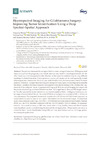Identificador persistente para citar o vincular este elemento:
https://accedacris.ulpgc.es/handle/10553/77082
| Título: | Hyperspectral imaging for glioblastoma surgery: Improving tumor identification using a deep spectral-spatial approach | Autores/as: | Manni, Francesca van der Sommen, Fons Fabelo, Himar Zinger, Svitlana Shan, Caifeng Edström, Erik Elmi-Terander, Adrian Ortega, Samuel Callico, Gustavo Marrero de With, Peter H.N. |
Clasificación UNESCO: | 3314 Tecnología médica | Palabras clave: | Ant-Colony-Based Band Selection Brain Imaging Deep Learning Glioblastoma Hyperspectral Imaging, et al. |
Fecha de publicación: | 2020 | Publicación seriada: | Sensors (Switzerland) | Resumen: | The primary treatment for malignant brain tumors is surgical resection. While gross total resection improves the prognosis, a supratotal resection may result in neurological deficits. On the other hand, accurate intraoperative identification of the tumor boundaries may be very difficult, resulting in subtotal resections. Histological examination of biopsies can be used repeatedly to help achieve gross total resection but this is not practically feasible due to the turn-around time of the tissue analysis. Therefore, intraoperative techniques to recognize tissue types are investigated to expedite the clinical workflow for tumor resection and improve outcome by aiding in the identification and removal of the malignant lesion. Hyperspectral imaging (HSI) is an optical imaging technique with the power of extracting additional information from the imaged tissue. Because HSI images cannot be visually assessed by human observers, we instead exploit artificial intelligence techniques and leverage a Convolutional Neural Network (CNN) to investigate the potential of HSI in twelve in vivo specimens. The proposed framework consists of a 3D–2D hybrid CNN-based approach to create a joint extraction of spectral and spatial information from hyperspectral images. A comparison study was conducted exploiting a 2D CNN, a 1D DNN and two conventional classification methods (SVM, and the SVM classifier combined with the 3D–2D hybrid CNN) to validate the proposed network. An overall accuracy of 80% was found when tumor, healthy tissue and blood vessels were classified, clearly outperforming the state-of-the-art approaches. These results can serve as a basis for brain tumor classification using HSI, and may open future avenues for image-guided neurosurgical applications. | URI: | https://accedacris.ulpgc.es/handle/10553/77082 | ISSN: | 1424-8220 | DOI: | 10.3390/s20236955 | Fuente: | Sensors (Switzerland)[ISSN 1424-8220],v. 20 (23), p. 1-20, (Diciembre 2020) |
| Colección: | Artículos |
Citas SCOPUSTM
61
actualizado el 08-jun-2025
Citas de WEB OF SCIENCETM
Citations
44
actualizado el 08-jun-2025
Visitas
112
actualizado el 14-dic-2024
Descargas
77
actualizado el 14-dic-2024
Google ScholarTM
Verifica
Altmetric
Comparte
Exporta metadatos
Los elementos en ULPGC accedaCRIS están protegidos por derechos de autor con todos los derechos reservados, a menos que se indique lo contrario.
